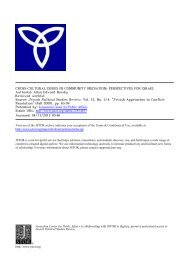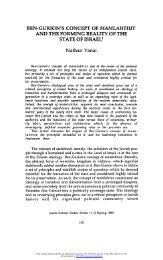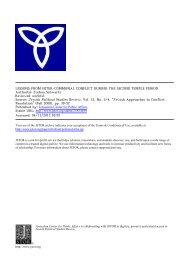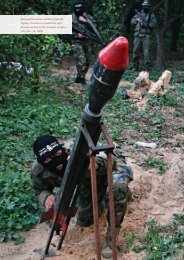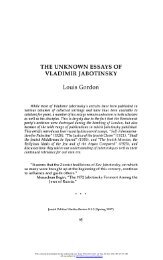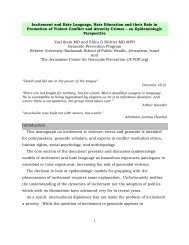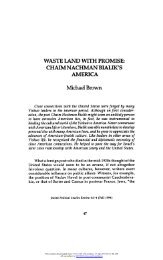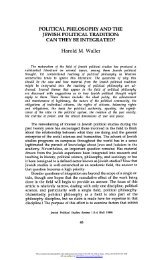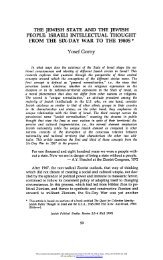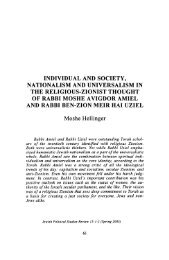the jewish community of cuba: between continuity and extinction
the jewish community of cuba: between continuity and extinction
the jewish community of cuba: between continuity and extinction
Create successful ePaper yourself
Turn your PDF publications into a flip-book with our unique Google optimized e-Paper software.
122 Margalit Bejaranomanufacture shoes, shirts, ties or underwear. Since clothing <strong>and</strong> lea<strong>the</strong>rgoods were mostly imported <strong>and</strong> very expensive,<strong>the</strong> cheap productsintroduced by<strong>the</strong> Jews were in high dem<strong>and</strong>, <strong>and</strong> <strong>the</strong> poor tailors <strong>and</strong>shoemakers were soon able to hire newerimmigrantsfor <strong>the</strong>ir sweatshops.23The institutional life <strong>of</strong> <strong>the</strong> Eastern European Jews beganwith a schism <strong>between</strong> <strong>the</strong> workers <strong>and</strong> <strong>the</strong>?"bourgeoisie"in 1925smallmerchants or owners <strong>of</strong> sweatshopswhose economic situation was notmuch better than that <strong>of</strong> <strong>the</strong>ir workers. The former created <strong>the</strong> KulturFarain (Cultural Society), while <strong>the</strong> latter founded <strong>the</strong> Centro Israelita de Cuba (Jewish Center <strong>of</strong> Cuba), both cateringto <strong>the</strong> social <strong>and</strong>spiritual needs <strong>of</strong> <strong>the</strong> Jewish immigrants.The Kultur Farain was considered <strong>the</strong> most active center <strong>of</strong> Jewishcultural <strong>and</strong> social life in <strong>the</strong> late 1920s. It had a large collection <strong>of</strong>books <strong>and</strong> periodicals,a choir, a dramatic circle, <strong>and</strong> provided eveningclasses for its members. Its leaders had close links with <strong>the</strong> CubanCommunist Party, founded in 1925, <strong>and</strong> <strong>the</strong>y joined <strong>the</strong> political struggle against <strong>the</strong> dictatorship<strong>of</strong> Gerardo Machado (1925-1933), five <strong>of</strong><strong>the</strong>m paying with <strong>the</strong>ir lives <strong>and</strong> several o<strong>the</strong>rs being expelledfromCuba.24Jewish presence in <strong>the</strong> early stages <strong>of</strong> Cuba's CommunistPartyaroused <strong>the</strong> interest <strong>of</strong> historians following <strong>the</strong> communist turn in FidelCastro's Revolution.Accordingto <strong>the</strong> minutes <strong>of</strong> <strong>the</strong> foundingsession <strong>of</strong><strong>the</strong> Cuban CommunistParty three out <strong>of</strong> <strong>the</strong> ten founders were Jews;25one <strong>of</strong> <strong>the</strong>m, Yunger Simchowitch, was destined to playa central role in<strong>the</strong> history<strong>of</strong> Cuban communism under <strong>the</strong> name <strong>of</strong> Fabio Grobart. Today,at <strong>the</strong> age <strong>of</strong> 85 <strong>and</strong> still an active member <strong>of</strong> <strong>the</strong> CentralCommittee <strong>of</strong> <strong>the</strong> Cuban Communist Party, Grobart denies his pastlinks with <strong>the</strong> Jewish <strong>community</strong>, but witnesses remember him as <strong>the</strong>most active propag<strong>and</strong>ist among <strong>the</strong> Jewish workers.26While <strong>the</strong> Kultur Farain functioned as an active social center untilit was closed in 1931 by <strong>the</strong> Cuban government, <strong>the</strong> Centro Israelita became <strong>the</strong> leading institution <strong>of</strong> CubanJewryas a result <strong>of</strong> its relationswith Jewish welfareorganizationsin <strong>the</strong> U.S. Social aid from U.S.Jewry was essential to save <strong>the</strong> immigrants from misery <strong>and</strong> to serve<strong>the</strong>ir immediate needs, but it was also intended to convince <strong>the</strong>m to remain in Cuba <strong>and</strong> give up <strong>the</strong>ir American dream.Representatives <strong>of</strong> <strong>the</strong> American Jewish welfare institutions functioning in Cuba directed all <strong>the</strong>ir financial supportto <strong>the</strong> Centro Israelita, hopingto transform it into a comprehensive communalorganization that wouldprovideall <strong>the</strong> social services for <strong>the</strong> Jewish population. Thus<strong>the</strong>y accelerated <strong>the</strong> development<strong>of</strong> local institutionallife, but <strong>the</strong>yalso weakened <strong>the</strong> independence <strong>of</strong> <strong>the</strong> local leadership<strong>and</strong>, in <strong>the</strong> long run, <strong>the</strong> Centro Israelita could not break free <strong>of</strong> its dependenceon U.S. Jewry.This content downloaded by <strong>the</strong> authorized user from 192.168.72.230 on Sun, 2 Dec 2012 04:14:50 AMAll use subject to JSTOR Terms <strong>and</strong> Conditions



